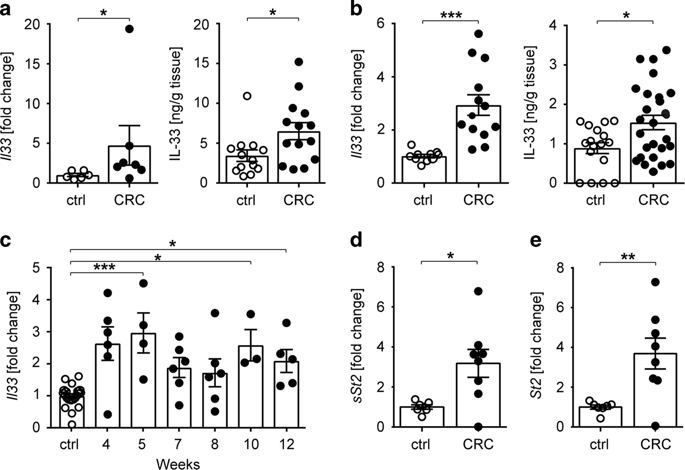Mucosal Immunology ( IF 8 ) Pub Date : 2019-06-05 , DOI: 10.1038/s41385-019-0176-y Eva Pastille 1 , Marie-Hélène Wasmer 2, 3 , Alexandra Adamczyk 1 , Vivian P Vu 2, 3 , Lukas F Mager 4 , Nhi Ngo Thi Phuong 1 , Vittoria Palmieri 1 , Cedric Simillion 5, 6 , Wiebke Hansen 1 , Stefan Kasper 7, 8 , Martin Schuler 7, 8 , Beat Muggli 9 , Kathy D McCoy 4 , Jan Buer 1 , Inti Zlobec 2 , Astrid M Westendorf 1 , Philippe Krebs 2

|
The composition of immune infiltrates strongly affects the prognosis of patients with colorectal cancer (CRC). Interleukin (IL)-33 and regulatory T cells (Tregs) in the tumor microenvironment have been separately implicated in CRC; however their contribution to intestinal carcinogenesis is still controversial. Here, we reveal that IL-33 signaling promotes CRC by changing the phenotype of Tregs. In mice with CRC, tumor-infiltrating Tregs preferentially upregulate IL-33 receptor (ST2), and IL-33/ST2 signaling positively correlates with tumor number and size. Transcriptomic and flow cytometry analyses demonstrate that ST2 expression induces a more activated and migratory phenotype in FOXP3+ Tregs, which favors their accumulation in the tumor environment. Consequently, genetic ablation of St2 reduces Treg infiltration and concomitantly enhances the frequencies of effector CD8+ T cells, thereby restraining CRC. Mechanistically, IL-33 curtails IL-17 production by FOXP3+ Tregs and inhibits Th17 differentiation. In humans, numbers of activated ST2-expressing Tregs are increased in blood and tumor lesions of CRC patients, suggesting a similar mode of regulation. Together, these data indicate a central role of IL-33/ST2 signaling in shaping an immunosuppressive environment during intestinal tumorigenesis. Blockade of this pathway may provide a strategy to modulate the composition of CRC immune infiltrates.
中文翻译:

IL-33/ST2 通路塑造调节性 T 细胞表型以促进肠癌
免疫浸润的组成强烈影响结直肠癌 (CRC) 患者的预后。肿瘤微环境中的白细胞介素 (IL)-33 和调节性 T 细胞 (Treg) 分别与 CRC 相关;然而,它们对肠道致癌作用的贡献仍然存在争议。在这里,我们揭示了 IL-33 信号通过改变 Tregs 的表型来促进 CRC。在患有 CRC 的小鼠中,肿瘤浸润性 Treg 优先上调 IL-33 受体 (ST2),并且 IL-33/ST2 信号与肿瘤数量和大小呈正相关。转录组学和流式细胞术分析表明,ST2 表达在 FOXP3 + Tregs 中诱导更活跃和迁移的表型,这有利于它们在肿瘤环境中的积累。因此,St2的基因消融减少 Treg 浸润并同时增加效应 CD8 + T 细胞的频率,从而抑制 CRC。从机制上讲,IL-33 减少 FOXP3 + Treg 产生 IL-17 并抑制 Th17 分化。在人类中,CRC 患者的血液和肿瘤病变中激活的表达 ST2 的 Treg 的数量增加,表明存在类似的调节模式。总之,这些数据表明 IL-33/ST2 信号在肠道肿瘤发生过程中塑造免疫抑制环境中的核心作用。阻断该通路可能提供一种策略来调节 CRC 免疫浸润的组成。



























 京公网安备 11010802027423号
京公网安备 11010802027423号